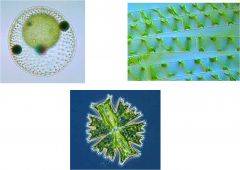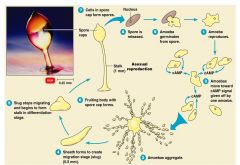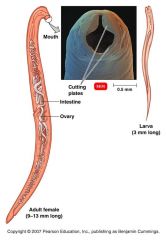![]()
![]()
![]()
Use LEFT and RIGHT arrow keys to navigate between flashcards;
Use UP and DOWN arrow keys to flip the card;
H to show hint;
A reads text to speech;
37 Cards in this Set
- Front
- Back

What is this showing and tell me about it?
|
Algae; not a taxon;photoautotrophic eukaryotes that are not plants;many groups that are not closely related to each other;some algae produce harmful algal blooms - HABs
|
|

Chlorophyta is?
|
green algae;chlorophylls a and b, cellulose in cell walls, storage molecule starch;probably the group from which plants evolved
|
|
|
Stramenopila (candidate kingdom)
|
contains several groups of algae and also the “water molds”
flagellated cells have 2 flagella, one with hairy projections phyla of algae Phaeophyta (brown algae) Bacillariophyta (diatoms) Oomycota - water molds |
|
|
Macrocystis
|
is giant kelp; is harvested off the coast of California, partly for algin
|
|
|
algin
|
algin is used as a thickener in many foods
algin is used in rubber tires and hand lotion |
|

Bacillariophyta
|
pictures of diatoms
|
|
|
domoic acid intoxication
|
produced by diatoms;can cause memory loss and diarrhea in humans
|
|

Picture of what?
|
Pseudonitzschia;causes harmful algal blooms HABs
amnesic shellfish poisoning ASP |
|

Picture of What?
|
Aureococcus anophagefferens;very tiny - nannoplankton;in recent decade causes “brown tides” on east coast (first noted in 1987);kills some filter-feeders by clogging their feeding apparatus
|
|

What's this?
|
Phytophthora infestans;late blight of potatoes
caused famine in Ireland |
|

What this?
|
Porphyra;source of nori
|
|

What's this?
|
Alexandrium;(a dinoflagellate);produces a saxitoxin - binds and blocks sodium ion channels;paralytic shellfish poisoning - PSP;
muscle relaxation - no breathing; |
|

What's this?
|
Pfiesteria piscicida;Possible Estuary Associated Syndrome (PEAS);massive fish kills;people also affected - memory loss, confusion, skin irritation, headaches, liver damage;found east coast of U.S.
|
|
|
Plasmodium
|
malaria; sexual reproduction in Anopheles mosquito - definitive host
infects human red blood cells - intermediate host |
|
|
Plasmodium vivax
|
benign malaria
|
|

|
Toxoplasma gondii;toxoplasmosis;cats are an essential part of the life cycle;sexual phase in the intestine of cats -definitive host
oocysts shed in feces |
|

|
Cryptosporidium parvum; cryptosporidiosis;choleralike diarrhea of 10-14 days’ duration;1957 recogized as human pathogen;oocysts ingested
|
|

|
Trichomonas vaginalis;has an undulating membrane;human parasite - found in vagina and male urethra - sexually transmitted - or on toilet seat-causes vaginitis with a copious, frothy greenish-yellow, foul smelling discharge
|
|

|
Giardia lamblia;giardiasis;archaezoan - found in small intestine of humans and other mammals;cysts excreted in feces;prolonged diarrhea, malaise, nausea, flatulence, weakness, weight loss, abdominal cramps - often with distinct odor of hydrogen sulfide in breath or stool
|
|

|
Entamoeba histolytica;amoebic dysentary;pathogenic
uses proteins called lectins to attach to galactose on the plasma membrane oligosaccharides causes cell lysis;transmitted through cysts in feces |
|

|
Naegleria fowleri;meningocephalitis -PAM (primary amoebic meningitis);Euglenozoan –probably not;contracted in swimming water - migrates via olfactory nerves to brain;fatality rate is nearly 100% - diagnosis at autopsy;Global warming
|
|

|
Leishmania;leishmaniasis;from female sand fly (Phlebotomus);widespread and complex disease
|
|

|
Trypanosoma brucei gambiense;African trypanosomiasis - sleeping sickness;bite of tsetse fly - death in 2-4 years
|
|

|
Trypanosoma cruzi;Chaga’s disease;protozoan disease of the cardiovascular system
occurs in southern Texas, Mexico, Central America and parts of South America;vector - reduviid bug - kissing bug bites near lips - may defecate while biting;disease most dangerous to children;parasite damages nerves controlling peristaltic action of esophagus or colon organs become grossly enlarged 10-30% die of complications after decades of infection |
|

|
Cellular slime mold Dictyostelium
|
|

|
Plasmodial slime mold, Physarum
|
|

|
Clonorchis sinensis;Asian liver fluke
|
|
|
Paragonimus westermani
|
lung fluke;Definitive host – humans – fluke lives in bronchioles; liberates eggs into bronchi; swallowed and released in feces
|
|

|
Schistosoma haematobium;blood flukes;Can cause damage to bladder, liver, brain;
Slender females live in a groove in the male, continually producing eggs;Schistosomiasis Debilitating disease;intermiadiate host is snails |
|

|
Taenia saginata; beef tapeworm
|
|

|
Taenia solium;pork tapeworm; humans can be both the definitive and intermediate host; can cause cysticercosis encysts in human tissues, sometimes in the eye, sometimes in the brain
|
|

|
Echinococcus granulosus;dog and wolf tapeworm; encysts in humans – hydatid cyst – brood capsule
|
|

|
Enterobius vermicularis;pinworms;
Eggs infective to humans;Females come out at night and lay eggs around the anus which becomes itchy and is scratched transferring eggs to hands |
|

|
Necator americanus;hook worms;Larvae penetrate through skin, even of foot;
Live in small intestine after traveling through lungs; Suck blood from intestinal lining |
|
|
Ancyclostoma duodenale
|
hook worm similar to Necator americanus
|
|

|
Ascaris lumbricoides;Infects over 1 billion people worldwide
Young worms pass through lungs before they settle in human small intestine;ascariasis; Eggs infective for humans |
|

|
Trichinella spiralis;trichinellosis;Acquired by eating undercooked pork, horsemeat or game especially bear;larvae encyst in human muscle, often in diaphragm and eye muscles
|

